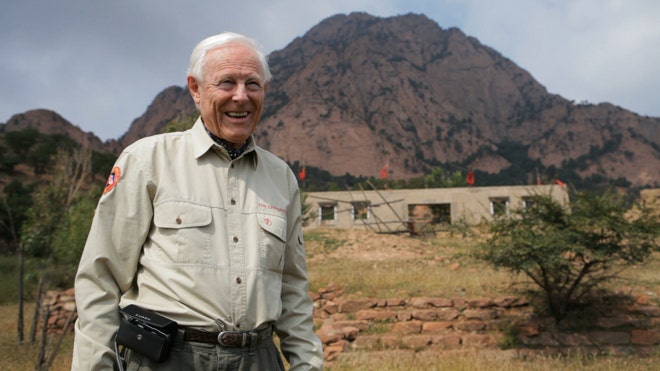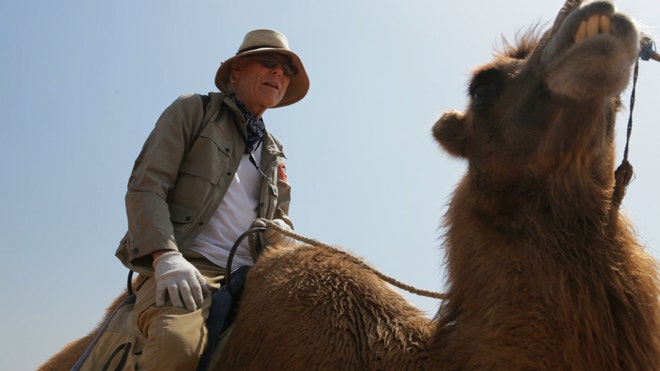FoxNews.com
The tomb of Mongolian emperor Genghis Khan -- who created the world’s most powerful empire by raiding and invading across Eurasia -- is a lost treasure archaeologists have sought for years. And one man thinks he knows where it is.
Last fall Alan Nichols, the president of the Explorers Club, mapped out possible locations for the tomb of Khan (also known as Chinnggis Qa'an). His hypothesis: Khan’s tomb is located in the Liupan Mountains in Northern China, where the emperor who was born in 1162 is said to have perished from an arrow wound in August 1227.
Next fall, Nichols plans the next phase of his research: pinpointing Khan’s exact resting place.
“Ghengis Khan’s tomb is my obsession,” Nichols, a noted authority on the emperor, exclusively told FoxNews.com. “I couldn’t stop thinking about it. But I’m not happy just reading about it, or knowing about it. I need to have my feet on it.”
The emperor is said to be buried in a solid silver casket with amazing jewels, weapons and artifacts, as well as an entourage of warriors, slaves and horses. If successful, its discovery would be mankind’s biggest archeological discovery since finding the tombs of the pharaohs in Egypt, researchers say.
'This would be on the scale of the discovery in Egypt of the tombs of Pharaohs.'
- Explorer Richard Garriott
“Alan has already done a great deal of the foundation work for this expedition, and while finding buried targets is always tricky and often does not succeed, Alan’s plan is both timely and possible,” explorer Richard Garriott, who has been on expeditions to the South Pole and the International Space Station, told FoxNews.com.
“The nomadic lifestyle of Genghis Khan and his people left a far more ethereal trace than many more settled civilizations. Finding the tomb would very likely unearth a wealth of artifacts that would tell the story of this important and powerful leader, in ways we will only speculate about otherwise,” he added.
Magnetometry, underground testing Ever since Marco Polo, explorers have been looking for the tomb of Chinnggis Qa'an, Nichols said. But new archaeology tools may help them succeed where others fail.
"Our current knowledge and tools concerning magnetometry and other underground testing techniques now available will vastly change the exploration opportunities,” Nichols said.
The place of Genghis Khan’s death is said by locals to be marked with a circle of stones. On Nichols' last trip, he had his team drive 1,300 miles to a remote mountain locale—seldom visited by anyone but the indigenous persons there—to retrace the path to the so-called sacred “Mountain X.”
Nichols now believes the Luipan Mountains that rise above the grasslands are the final resting place of the famed emperor, a short flight north of Hong Kong, near the Yellow River, off the coast of the Pacific Ocean. The site is 5,000 feet above sea level, and houses the ruins of a Buddhist temple, where smiling Buddhist sculptures overlooking the mountain.
There, Nichols and his colleagues Warren Caldwell, a PhD candidate in geophysics at Stanford University, and explorer Mike Pizzio roamed the ancient countryside in a Land Rover LR4. There are five so-called sacred mountains in China that have been the subject of imperial pilgrimages by emperors throughout history. Khan is said by lore and word of mouth to have died at the foot of one in the Luipan Mountains.
On his last day in the field, last fall, Nichols made a find on that mountainside: a marker with a message covered by moss. The clue was not in any of the books he’s read on Khan or searchable online. This inscription brought him another step closer to fulfilling this mission, he said.
“Genghis Khan was a brutal, bloodthirsty conqueror, but his death and the legacy he established deserve a historical marker,” Prof. Usha Haley, at West Virginia University, an expert on the Silk Road, and author of The Chinese Tao of Business, told FoxNews.com.
Ghengis Khan’s grandson Kublai Khan founded a dynasty in China, so the emperor’s legacy is a long-lasting one in Chinese history.
“Kublai Khan, who hosted Marco Polo, founded the Chinese Yuan dynasty which lasted for a century. Genghis Khan’s legacy includes carrying cultural and artistic accomplishments through the Pax Mongolica and over the Silk Road across the largest empire ever -- from the Pacific Ocean to modern-day Hungary, including Asia.
"Maintaining this empire required imaginative leadership, administrative skills, adroit use of the military technology of the day --along with outrageous violence and destruction.”
Many expeditions have tried in the past to find the tomb of the great warrior, but all have failed or proved inconclusive, relying on guidance from the Chinese government. Nichols’ and crew’s next trek -- next year is the scheduled timeframe -- may change history.
“This discovery would be on the scale of the discovery in Egypt of the tombs of Pharaohs. But in this case, there is one and only one Genghis Khan, not the rich lineage of Pharaohs found in Egypt,” Garriott told FoxNews.com.
Established in 1904, the Explorers Club is a professional society, like the National Geographic Society, dedicated to the advancement of field research. The club awards its distinguished “flag” to expeditions it deems important to furthering scientific knowledge in specific fields.


No comments:
Post a Comment